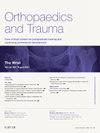糖尿病足及其并发症的基础科学综述
Q4 Medicine
引用次数: 0
摘要
糖尿病(DM)是一种糖代谢受损的慢性代谢紊乱,可导致广泛的全身并发症。其中,糖尿病足病理导致严重的发病率。本文综述了糖尿病足并发症的潜在机制,包括糖尿病神经病变、糖尿病足溃疡(DFU)、感染、伤口愈合受损、骨折愈合和Charcot神经关节病(CNA)。糖尿病性神经病变可导致保护性感觉丧失、平衡障碍、溃疡形成和下肢截肢风险增加。DFUs由协同缺血、神经病变和感染引起,通常进展为愈合能力差的慢性伤口。糖尿病足的感染通常是由金黄色葡萄球菌和其他病原体引起的,通常会导致严重的并发症,包括骨髓炎和截肢。糖尿病对骨骼健康有不利影响,通过破坏成骨细胞活性、慢性炎症和氧化应激导致骨折愈合延迟。CNA仍然是一种具有挑战性的疾病,其特征是局部过度炎症、骨吸收和进行性关节破坏,导致畸形和溃疡。目前,糖尿病足并发症的管理是预防性的,包括血糖控制、减压、感染管理和必要时的手术干预。尽管对病理学的理解有了进步,但在治疗策略上仍有很大的差距,需要进一步研究靶向治疗来减轻神经病变,促进伤口愈合,并保持肢体功能。本文章由计算机程序翻译,如有差异,请以英文原文为准。
A review of the basic science of the diabetic foot and its complications
Diabetes mellitus (DM) is a chronic metabolic disorder of impaired glucose metabolism, leading to widespread systemic complications. Among these, diabetic foot pathology contributes to severe morbidity. This review explores the underlying mechanisms of diabetic foot complications, including diabetic neuropathy, diabetic foot ulcer (DFU), infection, impaired wound healing, fracture healing, and Charcot neuroarthropathy (CNA). Diabetic neuropathy contributes to loss of protective sensation, balance impairment, ulcer formation, and an increased risk of lower limb amputations. DFUs arise from synergistic ischemia, neuropathy, and infection, often progressing to chronic wounds with poor healing capacity. Infections in diabetic feet are frequently caused by Staphylococcus aureus and other pathogens, often leading to severe complications, including osteomyelitis and amputations. Diabetes adversely affects bone health, resulting in delayed fracture healing through disrupted osteoblast activity, chronic inflammation, and oxidative stress. CNA remains a challenging condition, characterized by excessive local inflammation, bone resorption, and progressive joint destruction, leading to deformity and ulceration. Currently, management of diabetic foot complications is preventative, including glycaemic control, pressure offloading, infection management, and surgical interventions when necessary. Despite advancements in understanding pathology, there remain significant gaps in treatment strategies, necessitating further research into targeted therapies to mitigate neuropathy, enhance wound healing, and preserve limb function.
求助全文
通过发布文献求助,成功后即可免费获取论文全文。
去求助
来源期刊

Orthopaedics and Trauma
Medicine-Orthopedics and Sports Medicine
CiteScore
1.00
自引率
0.00%
发文量
57
期刊介绍:
Orthopaedics and Trauma presents a unique collection of International review articles summarizing the current state of knowledge and research in orthopaedics. Each issue focuses on a specific topic, discussed in depth in a mini-symposium; other articles cover the areas of basic science, medicine, children/adults, trauma, imaging and historical review. There is also an annotation, self-assessment questions and a second opinion section. In this way the entire postgraduate syllabus will be covered in a 4-year cycle.
 求助内容:
求助内容: 应助结果提醒方式:
应助结果提醒方式:


